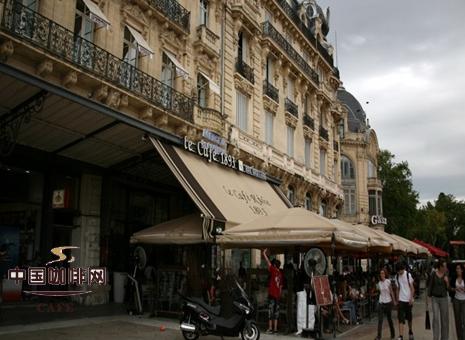The role of Egyptian Cafe in the Cultural History of Cafe

Red-brown wooden doors and windows, neat and warm red and white checked tablecloths-the Riche Cafe, built in 1908, has spent 103 years in Tahrir Square in the center of the Egyptian capital Cairo.
In the turmoil before Egypt's parliamentary elections, the formerly bustling city center was once again depressed, and most shops closed again, except for the cafe on the corner, whose windows glowed soft yellow. It is here that Najib Mahafords, a decades-old customer and Nobel Prize winner for literature, drinks coffee with his literary friends, observes life, talks about the current situation, and bears witness to the rise and fall of history.
The reporter came to the cafe again a few days ago. there was no reception desk or cashier, but there was a desk covered with magazines, notes, pencil containers and leaflets, and old yellowed books overlapped with new ones smelling of ink. teetering on the shelf behind. The shopkeeper, Mr. Majid, refused to be interviewed by a reporter a year ago. The kind-hearted man quietly explained that there are many buildings such as Al-Ahram and the journalists Association nearby, and many influential writers and writers go in and out every day, and the shopkeeper does not want this place to become a lively place for "ignorant tourists" to rest.
On the floor of the inner hall leading to the kitchen, I was surprised to see a narrow spiral staircase, down the steps, is a small bar transformed from a strip basement of less than 20 square meters, but there are no guests inside. An Egyptian friend named Abbas led the reporter to the bar at the end of the bar. The wine rack leaning against the wall was filled with vodka, gin and other wine. Abbas nudged the middle grid, and the wine rack turned out to be a small secret room. the stairs inside lead to the ground.
Abbas said that in the fight against the British colonists in 1919, students who translated foreign documents and made anti-British leaflets were frequently hunted, and the underground warehouse of the cafe became a temporary printing room and safe haven. At that time, when there was no electricity, the students were busy lighting candles in the claustrophobic space, the stairs in the hall were covered by tables, and the stairs in the secret room were used for escape.
After the victory of the revolution, the basement fell into decades of silence. It was not until the 1990s that it was transformed into what it is now. Abbas said that over the past 20 years, whenever friends in the cultural circle have published important works, people gather here to celebrate and sign autographs, but they have not been open to the public.
Struggling to climb the turnstile back to the main cafe, I told the story of being shut down a year ago. Abbas smiled and pulled a chair to me and said, "those who come to Tahrir Square at this time should not be 'ignorant tourists'." He looked around and introduced one by one. The old man sitting alone in a corner of the cafe, wearing a cylindrical red felt hat and a goatee, was a writer returning from France, a middle-aged man surrounded by the crowd and dignified in a dark brown jacket. he is a well-known media man who owns two newspapers; there are also British styling artists who have come to collect styles and German teachers who have lived here for a long time in Cairo.
Some young people shuttled from table to table, whispering and laughing with fragrant Turkish coffee and Arabica tea. The guests here talked about the same topic from time to time-the demonstration in Tahrir Square.
When the reporter left, he noticed dozens of black-and-white photos outside the window, recording Tahrir Square in different periods outside the cafe window for more than a hundred years. There is a hope in the reporter's heart that no matter how things change, this long and cultural cafe will open normally every day to welcome visitors from all directions and witness the future of Egypt and Cairo.
Important Notice :
前街咖啡 FrontStreet Coffee has moved to new addredd:
FrontStreet Coffee Address: 315,Donghua East Road,GuangZhou
Tel:020 38364473
- Prev

General knowledge of Coffee Culture the History and Culture of Cuban Coffee
In 1748, coffee was introduced into Cuba from Dominica, and Cuba began to grow coffee ever since. With fertile land, humid climate and abundant Rain Water, Cuba can be called a natural treasure land for coffee cultivation. The suitable natural conditions provide a favorable natural environment for the growth of coffee trees, and coffee is well planted and developed here. In Cuba, the cultivation of coffee is regulated by the state. Cuba is the most
- Next

The origin of coffee fame and fortune cappuccino coffee name
The origin of the cappuccino name cappuccino coffee is a change of Italian coffee, that is, on the strong coffee, pour steamed milk, when the color of the coffee is like the headscarf on the dark brown coat of the cappuccino church monks, hence the name coffee. It sounds complicated. Take a look at the following analysis. It turns out that the church of St. Franciscan was founded after 1525.
Related
- How did the Salvadoran coffee industry develop in Central America?
- What exactly does the golden cup extraction of coffee mean?
- The Origin of Coffee flower
- [2023 Starbucks World Earth Day] there are more meaningful things besides free Starbucks coffee!
- What kind of coffee is there in Spain? 9 Flavors of Spanish Coffee
- Aromatic African coffee| Kenya's coffee culture and historical production area
- Liberica Coffee Bean knowledge: the characteristics of Liberian Coffee beans of the three original species of Coffee beans
- The origin and formula of Spanish latte introduces the taste characteristics of Bombon coffee in Valencia, Spain.
- How to adjust the solution of over-extracted coffee
- What is the tasting period of coffee beans? What is the period of coffee and beans? How should coffee wake up and raise beans?

